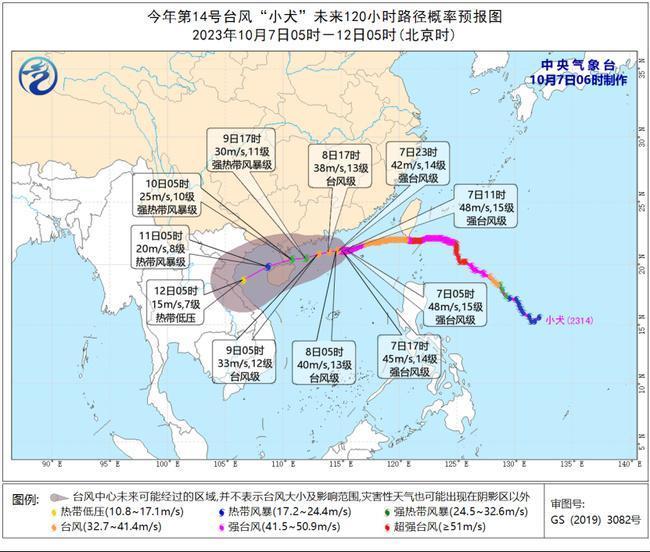The China Meteorological Administration has issued a yellow alert for Typhoon Koinu, the 14th typhoon of the year, as it approaches the coastal areas of Western Guangdong and Eastern Hainan Island.

As of 5 AM today, the centre of Typhoon Koinu, categorized as a severe typhoon, was located just south of the city of Shanwei in Guangdong Province. The typhoon’s maximum sustained wind speed near its centre reached 48 meters per second, with a minimum central pressure of 945 hPa.
Typhoon Koinu is expected to move west-south-westward at a speed of 5 to 10 kilometres per hour, maintaining its intensity or slowly weakening. It is forecasted to gradually approach the coastal areas of Western Guangdong and Eastern Hainan Island.
Wind Forecast: From 8 AM today until 8 AM tomorrow, there will be strong winds of levels 6 to 8, with gusts reaching levels 9 to 10, in the eastern part of the East China Sea, the Taiwan Strait, the northern part of the South China Sea, and along the coastlines of Zhejiang, Fujian, and Guangdong. Some areas of the Guangdong coast and the northern South China Sea will experience strong winds of levels 9 to 12, with gusts reaching levels 13 to 14. Near the centre of Typhoon Koinu, sea areas can expect winds levels of 13 to 15, with gusts up to 16 to 17.
Precipitation Forecast: From 8 AM today until 8 AM tomorrow, heavy rain or torrential rain (50-60 millimeters) is expected in the eastern coastal areas of Zhejiang, southeastern Fujian, and eastern Guangdong.
Safety Precautions Issued:
Outdoor activities, especially large gatherings and high-altitude operations, should be suspended.
Reinforce or dismantle structures susceptible to strong winds. People should avoid unnecessary outdoor activities and stay in secure, wind-resistant locations.
Ensure that the elderly and children remain in the safest part of their homes. Residents of unstable houses should be evacuated promptly. When the typhoon centre passes, winds may temporarily weaken or stop, but remember that strong winds can suddenly return, so it is essential to stay in a safe place. Relevant regions should be vigilant against the possibility of heavy precipitation triggering flash floods and geological disasters.
Related article: How does a typhoon form?






